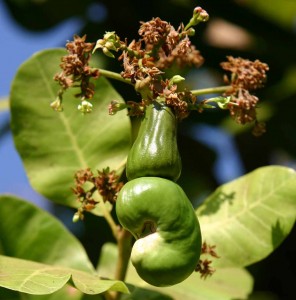Cashew Tree: Source for Nuts, “Apples,” Even Brake Linings
Posted in Exhibitions, Science, The Edible Garden on August 25 2009, by Plant Talk
 |
John Mitchell is a Research Fellow with the Institute of Systematic Botany at The New York Botanical Garden, where he also chairs the Library Committee. He studies the cashew family (Anacardiaceae) worldwide. |
 The cashew tree (Anacardium occidentale), a native of Brazil, is the source of cashew nuts and the cashew apple. Wild cashew trees occur in the savannas and some coastal forests in northern South America, Brazil, and adjacent Bolivia and Paraguay. Portuguese colonists introduced the cashew from Brazil to their colonies in India and Africa in the late 1500s. Today cashew is cultivated throughout the lowland tropics of the world. The majority of people who live in the tropics use the cashew tree primarily for its cashew apple rather than for the seed (which you know as the cashew nut).
The cashew tree (Anacardium occidentale), a native of Brazil, is the source of cashew nuts and the cashew apple. Wild cashew trees occur in the savannas and some coastal forests in northern South America, Brazil, and adjacent Bolivia and Paraguay. Portuguese colonists introduced the cashew from Brazil to their colonies in India and Africa in the late 1500s. Today cashew is cultivated throughout the lowland tropics of the world. The majority of people who live in the tropics use the cashew tree primarily for its cashew apple rather than for the seed (which you know as the cashew nut).
The seed is enclosed in a brown to gray fruit, often called the cashew nutshell, which contains a dermatitis-causing poisonous resin. This resin is chemically similar to that found in poison ivy (Toxicodendron radicans), to which the cashew is closely related; they are both members of the same family (Anacardiaceae) along with other commercial crops, including pistachio, pink peppercorn, and mango.
Cashew nuts are roasted or eaten raw after careful separation from the poisonous shell (fruit); chemicals in the nutshell liquid are extracted to produce adhesives, lubricants, solvents, plastics, and antimicrobials. Brake linings of cars and particleboard are two products partially derived from cashew nutshell chemicals. Cashews are also used to make cashew butter, or as an ingredient in cakes, cookies, and candies. Large-scale commercial cashew production is done in Brazil, tropical Africa, India, and Southeast Asia.
The cashew apple is a pear-shaped juicy structure that subtends the fruit and is actually the swollen flower/fruit stalk (pedicel) called a hypocarp. (Above is a photo of an immature cashew fruit and hypocarp developing on a tree, taken by Susan K. Pell, BBG.) The cashew apple can be candied or its juice fermented to make wine or spirits, or it can be used as an ice cream flavoring. The “apple” attracts dispersers such as fruit bats, coatis (relatives of raccoons), monkeys, lizards, and various fruit-eating birds who discard the poisonous fruit and consume the cashew apple.
My apprenticeship with Garden senior curator Dr. Scott Mori in the early 1980s resulted in the publication of a monograph, The Cashew and Its Relatives (Anacardium: Anacardiaceae), published by NYBG Press. The cashew genus, Anacardium, was originally described by Linnaeus and includes 11 species native to South and Central America.
Please help support important botanical research such as this that is integral to the mission of The New York Botanical Garden.

